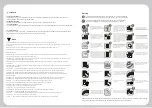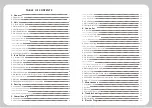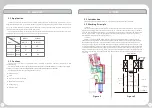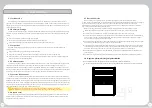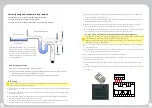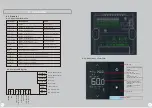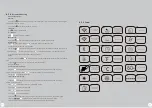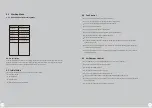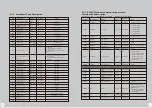
3
.
8
.
1
Drainage Pipe Test
Correctly designed condensate trap (below)
Condensate system under normal operating conditions
:
1. Level A reflects the negative static pressure.
2. Level C is at least 2 times the maximum negative static pressure.
If the unit is installed in a house before renovation, it is recommended to test before ceiling renovation
§
Please have a test after the installation of the drainage pipework.
§
During the test, determine whether the water
fl
ow is passing through the pipeline correctly, and carefully observe the
§
connection to ensure that there is no water leakage at the connection
§ Avoid placing the humidity probe near heat sinks or exposed to direct sunlight, because temperature
§
changes will affect Actual detection value.
The control circuit of the dehumidifier has been marked with different colors to prevent confusion. The
§
unit design adopts single-phase AC power supply.
§ Before the unit is connected to the main power supply, check the single-phase AC power supply to
§
ensure that the fluctuation range of the supplied voltage does not exceed the set point.
Prepare ±10% of marked voltage and frequency. For high load occasions (due to the conversion of larger
§
electrical equipment) can cause voltage Volatility, this check is particularly important.
3.
10
Connection of external sensitive components (control parts)
Dehumidification equipment can be pre-arranged wiring to cooperate with the external control system,
and provide wiring terminals for connecting external control components.
Do not install the panel where the relative humidity cannot be accurately detected, such as near a window
§
or near a water source
The humidity detection element should be installed at a position 1 meter to 1.5 meters above the ground
§
in order to detect representative water in the controlled area.
Flat, or laid at the inspection point according to the design requirements.
§
The unit must be grounded and a power isolation switch is provided to ensure that the equipment is cut
§
off during inspection and service.
comply with the following requirements:
The power supply of the dehumidification unit is equipped with a leakage protection device to make the
§
unit safer.
The dehumidification unit cannot be operated at a voltage and frequency beyond the manufacturing
§
range.
When installing the humidity detection element (sensitive element), its installation position should
11
Installed near the dehumidification equipment. The selection of the power supply cable and the main fuse
§
should correspond to the correct operating power of the dehumidification unit.
standards at the location of the equipment.
The fusing power of the power supply fuse must be consistent with the power and type of the installed
§
dehumidification equipment. The fuse should be installed
3.9
Wiring
The external control system must be compatible with the low-voltage control circuit of the dehumidification
§
equipment.
The electrical connection must be performed by qualified personnel in accordance with the electrical
The detection element should be installed in a location that is not affected by dry or humid air and airflow
§
outside the control area.
N
L H M L
NONC
C
fan
L
N
comp
valve
B2
A2
0-10V
C2
C1
GND
T e m p . & H u m i d i t y S e n s o r
0-10V
12V
A1
B1
A
B
+
-
-U2
12
C O N T R O L L E R
Negative pressure
Condensate pan
The fan is running
The difference between A and C is at least the
negative static pressure of normal operation.
According to experience, the difference is higher
than the negative static pressure of normal
operation. Dirty filter or working fan will cause
higher negative pressure.


